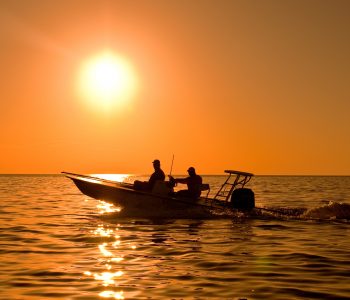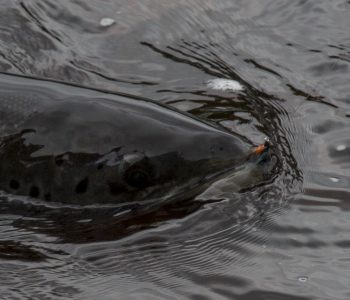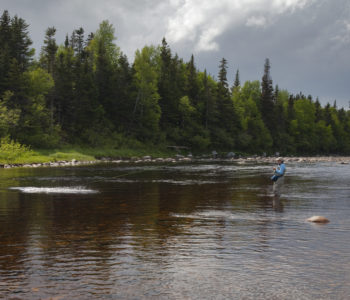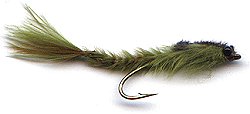
A new generation of hairwing patterns
Let me give you a little background about the arising of my most popular hairwings ever. The first prototypes arose in 1988 at the River Bondal where I became enormous successful after 4 blank Salmon years with a fly I called the Bondal Silver. I designed the pattern in a cabin close to the banks of the river during one of these days where you better could stay inside due to unbelievable bad weather conditions. The Bondal Silver was the first pattern on which I caught a salmon below the surface. Until then I only had succeed with dries in the north and central Scandinavia. After my success with the Bondal Silver I got more interested in hairwings and my confidence started to building up. Between 1989 and 1991, I did some extensive experiments with the same patterns in central Norway, basing these tests particularly on the length of the wing. My conclusions were striking. In the same period, I also started some other experiments with different beard or throat hackle material. The magic touch I got while I was after salmon in the estuaries of the Fosen peninsula at Norwegians west-coast.
When I had sent a few of my latest patterns to the USA I started to concentrate myself even more on hairwings. The greatest motivation to continue with these ideas was because the conclusion my American friend Dick Lemmerman was coming to. He was really crazy about one particular pattern of my Bondal series; the Bondal Black was his absolute favourite for the Margaree River in Nova Scotia. Dick renamed the fly to the “The Dutchman’s Balls” -. I have no idea why but the name already became so popular that I have to use it myself to prevent confusions. With the advent of the Bondal Black, even more hairwings within the same series evolved and they larger and larger. Today the Bondal series include about 13 difference patterns, which are worthwhile to try for Atlantic Salmon in Europe, Russia and eastern North-America.
The dressings and more backgrounds
Hairwings are an easy tie, but I insist on some differences based on my personal preferences and experience. First, for me the hook must be down eyed because I fish my flies with a lot of action and just below the surface. I firmly recommended the CS42 or Bomber hook from Partridge. The shape is beautiful . I believe that a down-eye hook with special kind of knots produces a more natural drift during fishing and a superior-hooking angle. The hook has a fine wire, is very sharp and extremely durable and the barb is small and easy to remove. During the years I fished many waters in which barbed hooks were not allowed and I didn’t find any differences between using a barb or not. The greatest difference with my new generation of hairwings has to do with the beard (or throat) of the fly. Nowadays I use dyed rabbit fur exclusively for all the beards on my Bondals and Pulsars. I prefer to use the soft and long hairs of a zonkerstrip – and use a considerable bunch of it. I take very long fibres, sometimes even almost reaching the hook point. I tie it in long and with a very good reason. A long beard you can make shorter easily just by pulling it off between thumb and forefinger. The fly has an unbelievable action and definitely has a superior attraction for fish. Although many people say that traditional jungle cock eyes sometimes can be deadly, I removed them from all my fishing flies. I find no evidence that they do any good whatsoever. In order to give my flies a personal touch, I tied in a tail of teal fibres and add a few longer fibres of teal as a sheath over the wing as a kind of topping. Finally I use a more powerful technique to secure the wing because I prefer durability above appearance. This technique you will find in the tying instructions. A beautiful small head of the fly surely looks great but do you think the fish would mind?
My 13 most effective patterns from this new series of hairwings are:
no 1: Bondal Black
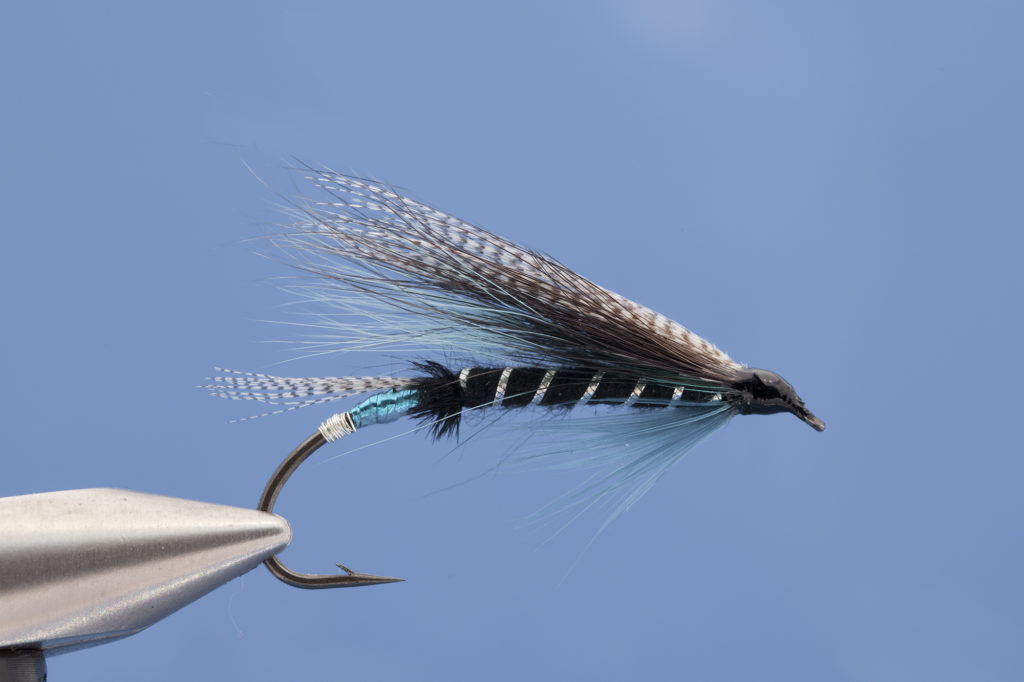
Hook: Daiichi 2110 and 2117 size 10-4
Thread: Uni-thread 8/0 black
Tag: Fine silver wire
Tail: A few fibres of mallard or teal
Butt: Blue fluorescent nylon wool tied much longer than normal (substitutes for all patterns: floss, Uni nylon stretch or Wapsi’s super bright dubbing)
Rib: Oval silver tinsel medium size
Body: Peacock herl or as substitute Wapsi’s Super Bright peacock dubbing
Beard: A nice bunch of rabbit fur, dyed kingfisher blue
Wing: Dyed blue squirrel tail (bottom)
Fitch tail (middle) substitutes: black bear or natural black squirrel
Mallard or teal fibres (top)
Head: Black
Excellent fly for dark rainy days. Killer on the Margaree River in Nova Scotia Great fly for the Norwegian west coast.
no 2: Bondal Silver
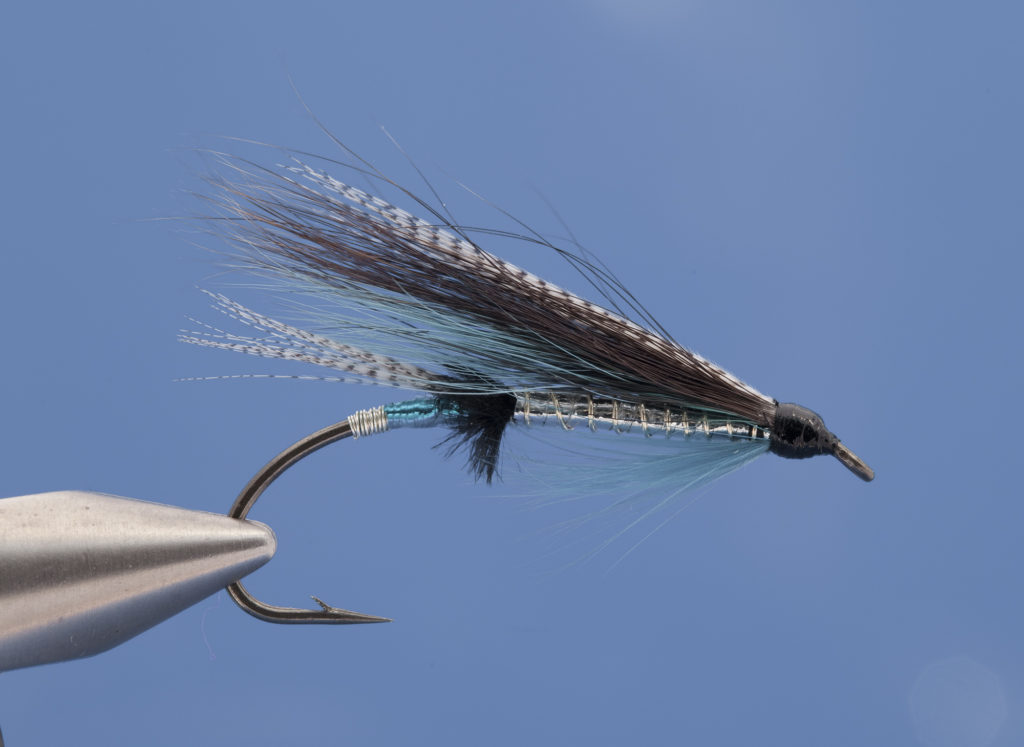
Hook:Daiichi 2110 and 2117 size 10-4
Thread: Uni-thread 8/0 black
Tag: Fine silver wire
Tail: A few fibres of mallard or teal
Butt: Blue fluorescent nylon wool or substitutes
Rib: Oval silver tinsel medium size
Body: Flat silver tinsel. Worthwhile to try is holographic mylar tinsel.
Beard: A nice bunch of rabbit fur, dyed kingfisher blue
Wing: Dyed blue squirrel tail (bottom)
Fitch tail (middle)
Mallard or teal fibres (top)
Head: Black
Superb fly for estuaries, sea pools and fresh running fish and also a good fly for sea trout in Norway.
no 3: Tony’s First Choice
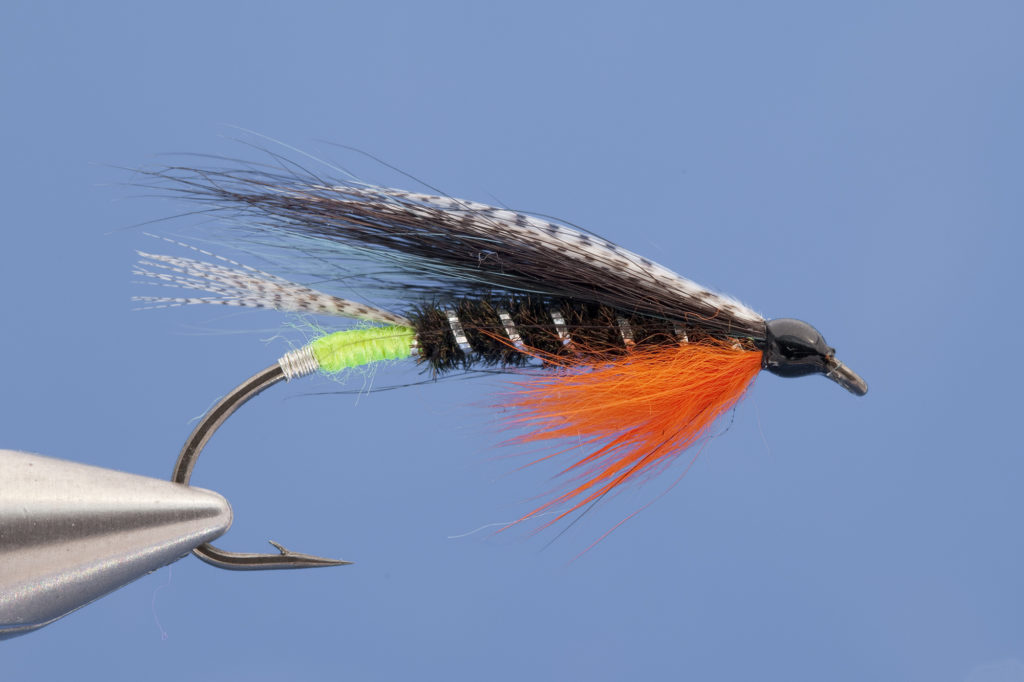
Hook:Daiichi 2110 and 2117 size 10-4
Thread: Uni-thread 8/0 black
Tag: Fine silver wire
Tail: A few fibres of mallard or teal
Butt: Yellow fluorescent dept ray nylon wool, tied much longer than normal
Rib: Oval silver tinsel medium size
Body: Peacock herl
Beard: A nice bunch of rabbit fur, dyed hot orange
Wing: Dyed blue squirrel tail (bottom)
Fitch tail (middle)
Mallard or teal fibres (top)
Head: Black
My best Salmon fly for Scandinavia. Killer in the Grey River and succeed in many other rivers in Atlantic Canada.
no 4: Clearwater Special

Hook:Daiichi 2110 and 2117 size 10-4
Thread: Uni-thread 8/0 black
Tag: Fine silver wire
Tail: A few fibres of mallard or teal
Butt: Yellow fluorescent dept ray nylon wool, tied much longer than normal
Rib: Oval silver tinsel medium size
Body: Peacock herl
Beard: A nice bunch of rabbit fur, dyed fluorescent green
Wing: Dyed green squirrel tail (bottom)
Fitch tail (middle)
Mallard or teal fibres (top)
Head: Black
Superb fly for the Miriamichi and tributaries. Very effective when rain coloured the water.
no 5: 1997

Hook:Daiichi 2110 and 2117 size 10-4
Thread: Uni-thread 8/0 black
Tag: Fine gold wire
Tail: A few fibres of teal dyed yellow
Butt: Yellow fluorescent stretch nylon tied much longer than normal
Rib: Oval gold tinsel medium size
Body: Golden holographic mylar tinsel
Beard: A nice bunch of rabbit fur, dyed fluorescent yellow
Wing: Dyed yellow squirrel tail (bottom)
Fitch tail (middle)
Teal fibres dyed yellow (top)
Head: Black
Best salmon fly during the 1997 season in Newfoundland and Labrador.
no 6: Where-ya-Wannebee Special

Hook:Daiichi 2110 and 2117 size 10-4
Thread: Uni-thread 8/0 black
Tag: Fine gold wire
Tail: A few fibres of mallard or teal
Butt: Yellow fluorescent stretch nylon tied much longer than normal
Rib: Oval gold tinsel medium size
Body: Peacock herl
Beard: A nice bunch of rabbit fur, dyed fluorescent yellow
Wing: Dyed yellow squirrel tail (bottom)
Fitch tail (middle)
Mallard or teal fibres (top)
Head: Black
Killer in most rivers of western Newfoundland. Named after the lodge from were we organised our fishing trips. Superb fly for waters with a high concentration of tannic acid.
no 7 and 8: Orange Bondal and Golden Orange Bondal
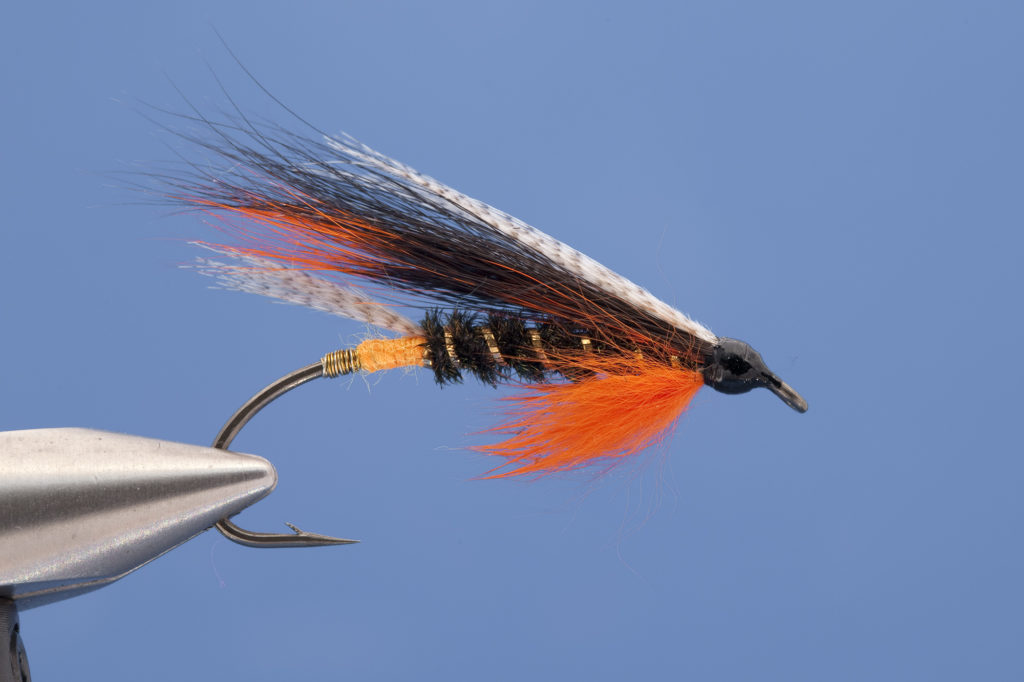
Hook:Daiichi 2110 and 2117 size 10-4
Thread: Uni-thread 8/0 black
Tag: Fine gold wire
Tail: A few fibres of mallard or teal
Butt: Orange fluorescent nylon wool tied much longer than normal
Rib: Oval gold tinsel medium size
Body (Orange Bondal): Peacock herl
Body (Golden Orange Bondal): Golden holographic mylar tinsel
Beard: A nice bunch of rabbit fur, dyed fluorescent orange
Wing: Dyed orange squirrel tail (bottom)
Fitch tail (middle)
Mallard or teal fibres (top)
Head: Black
Very good fly for waters with a high concentration of tannic acid.
no 9: Stordals Killer
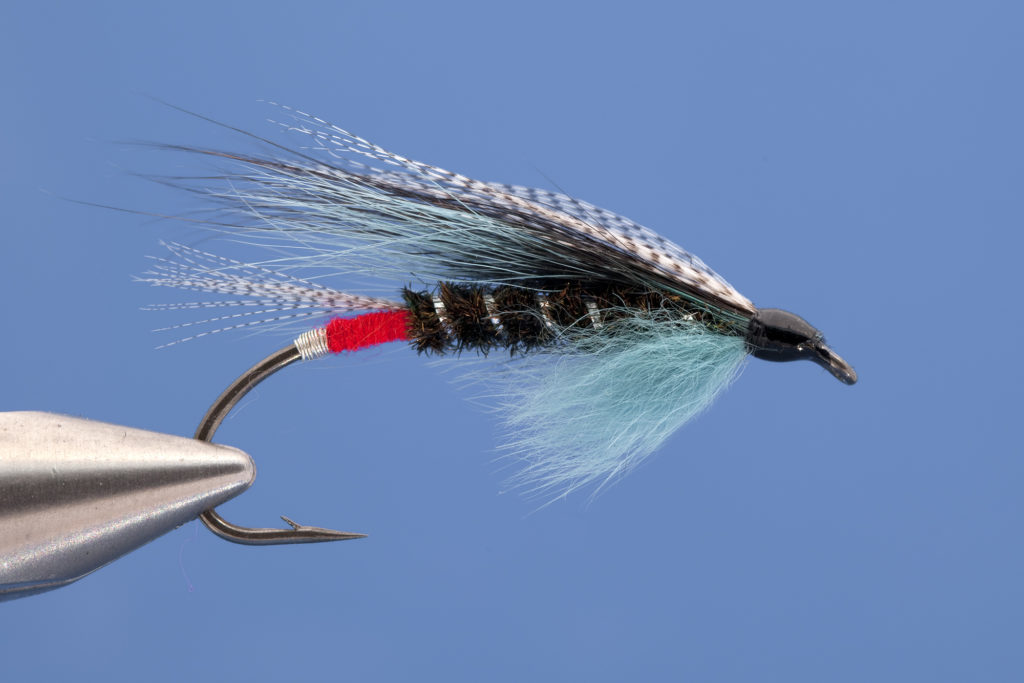
Hook:Daiichi 2110 and 2117 size 10-4
Thread: Uni-thread 8/0 black
Tag: Fine silver wire
Tail: A few fibres of mallard or teal
Butt: Red fluorescent wool tied much longer than normal
Rib: Oval silver tinsel medium size
Body: Peacock herl
Beard: A nice bunch of rabbit fur, dyed fluorescent blue
Wing: Dyed blue squirrel tail (bottom)
Fitch tail (middle)
Mallard or teal fibres (top)
Head: Black
Good fly for dark days, high water and late evening. Named after the Stordals River in Norway where this pattern tempts most fish during a certain day in the 1989 season.
no 10 and 11: Green Bondal and Yellow Green Bondal
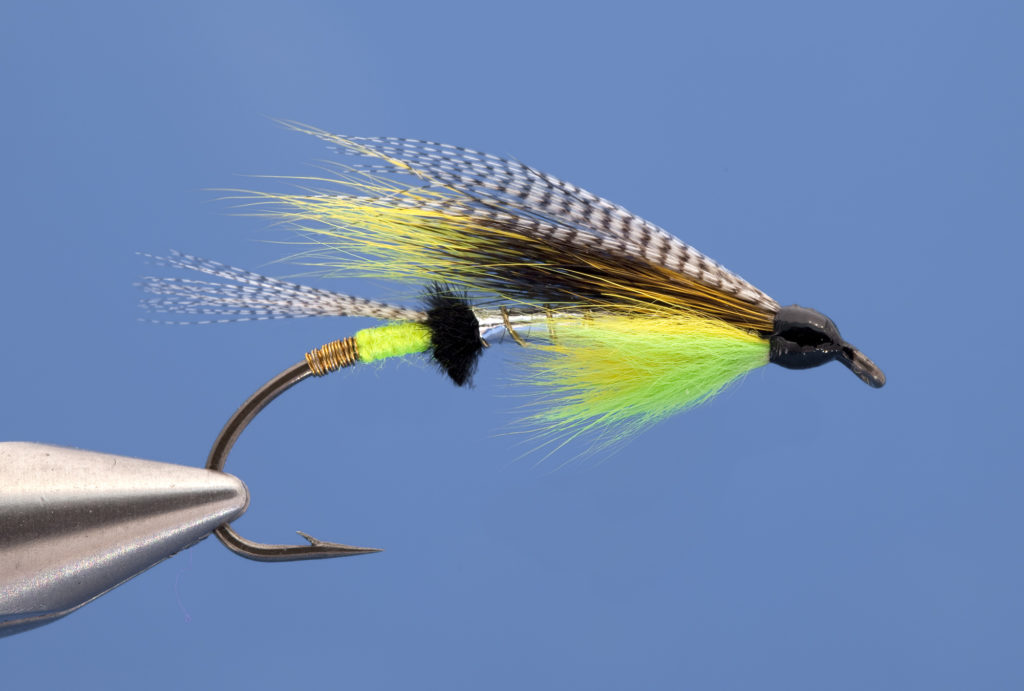
Hook:Daiichi 2110 and 2117 size 10-4
Thread: Uni-thread 8/0 yellow
Tag: Fine silver wire
Tail: A few fibres of mallard or teal
Butt (Yellow Green Bondal): Yellow fluorescent stretch nylon tied much longer than normal
Butt (Green Bondal): Green fluorescent stretch nylon tied longer then usual
Rib: Oval silver tinsel medium size
Body: Flat silver tinsel
Beard (Yellow Green Bondal): A nice bunch of rabbit fur mixed from dyed fluorescent yellow and green
Beard (Green Bondal): A nice bunch of dyed fluorescent green rabbit (same colour as tag)
Wing: Dyed yellow squirrel tail (bottom)
Dyed green squirrel tail (middle)
Mallard or teal fibres (top)
Head: Yellow
I like this fly most directly after a rain shower
no 12 and 13: Second Change and Last Chance
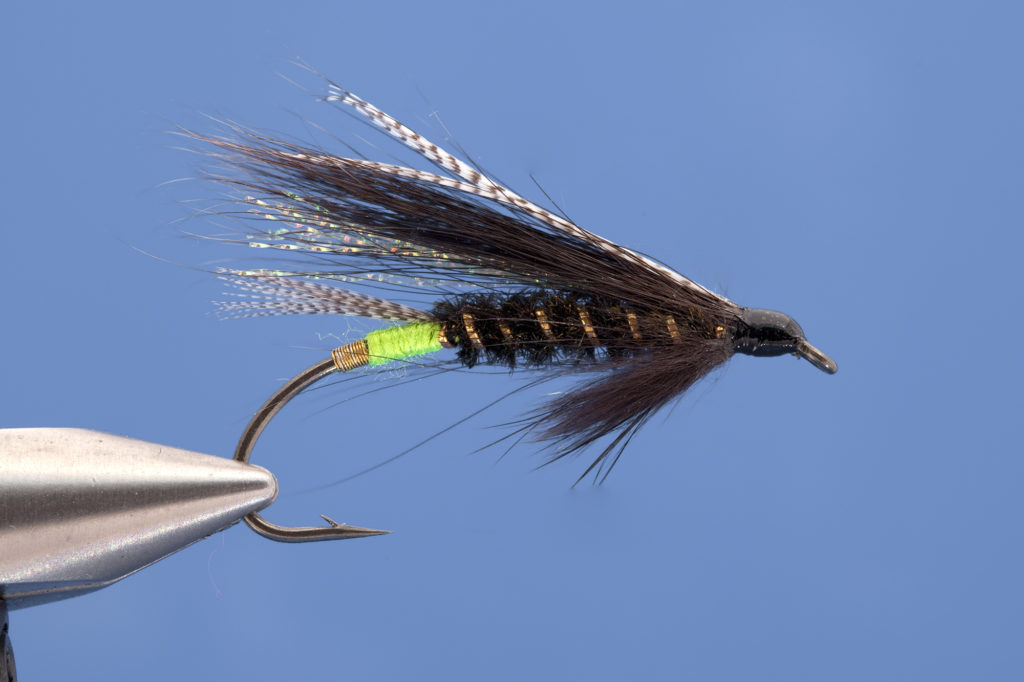
Hook:Daiichi 2110 and 2117 size 10-4
Thread: Uni-thread 8/0 black
Tag: Fine gold wire
Tail (Second Chance): A few fibres of teal
Tail (Last Chance): A few fibres of mallard or teal dyed yellow
Butt: Yellow fluorescent stretch nylon tied much longer than normal
Rib: Oval gold tinsel medium size
Body (Second Chance): Peacock herl
Body (Last Chance): Golden holographic mylar tinsel
Beard: A nice bunch of rabbit fur natural black colour
Wing (Second Chance): Crystal flash or Angel hair mixed colours (bottom)
Fitch tail (middle)
Mallard or teal fibres (top)
Wing (Last Chance): Crystal flash or Angel hair mixed (bottom)
Fitch tail (middle)
Mallard or teal fibres dyed yellow(top)
Head: Black
Excellent flies to offer you a Second or Last chance after you rolled a fish.
TYING TECHNIQUE FOR THE BONDAL SERIES (see drawings)
Step 1

Put on tying thread and tie in a piece of round tinsel or wire.
Step 2

The way I prefer is to secure the wire on the hook shank and wrap a few windings towards the bend. Then I wrap it back so that there is a double layer. Tie in the tail of teal fibres in front of the tag. Take a piece of fluorescent nylon or floss and secure it on the hook shank .
Step 3

Make a nice long butt. Using up to 5 windings is no problem. Tie in the tinsel for the rib and 3 or 4 long peacock herls for body.
Step 4

Make a nice body from peacock and secure with the ribbing with opposite windings. Tie in a long bunch of soft rabbit fur as beard or throat. The traditional way to make the wing is to build it up. The squirrel tail fibres are added first, than the fitch tail and finely the mallard fibres over all.
For my fishing flies I use a different technique to secure the wing. The reason for this is very simple. Just take some hairwings from somebody’s fly box and give a strong pull at the wing. In many cases you will separate the wing from the fly. The other reason is that during time the lacquer dries out and looses the holding. To make the wing more durable I use following technique: I tie in the wing at the bottom of the fibres on the thickest part. The top of the wing must be pointed in the opposite direction of the hook eye. I tie it in very strong and than pull the wing backwards. Finely I tie off the wing as strong as possible. The head will be a little bigger but you will never lose the wing anymore. Secure well and tie off.
Step 5

The completed fly


